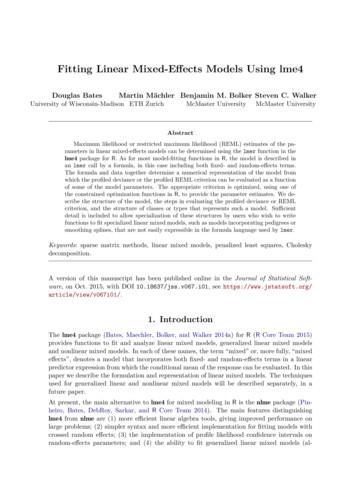Price Competition In A Mixed Oligopoly Market
Price Competition in a Mixed OligopolyMarket1Amarjyoti MahantaSeveral studies on mixed oligopoly indicate that the ownershippattern of firms does not affect the equilibrium price. This idea oftensuggests that ownership is irrelevant. In a mixed duopoly underprice competition, firm ownership is irrelevant. This study revealsthat ownership is irrelevant in a single publicly owned firm and inany positive number of privately owned firms. However, if two ormore publicly owned firms exist, then ownership becomes relevantin a homogeneous good market with a strictly increasing convexcost schedule and a downward sloping demand curve. If firms setthe price sequentially and if the lone public firm is a price leader,then social welfare is constantly greater than when the latter is aprice follower. The unique price is the competitive price when thepublic firm moves first in the sequential game.Keywords: Mixed oligopoly, Price competitionJEL Classification: L13, L32, L33* Assistant Professor, Centre for Development Studies, Prasanth Nagar,UlloorKerala, India 695011. (E-mail): amarjyotimahanta@gmail.com, (Tel): 91808-9735892, (Fax): 91-471-2447137.This paper is based on a chapter from my PhD dissertation. I am grateful tomy supervisors, namely, Professor Anjan Mukherji and Professor KrishnenduGhosh Dastidar. I also express my gratitude to the participants of the seminarheld at the Centre for Economic Studies and Planning, Jawaharlal NehruUniversity, particularly to Dr. Taposik Banerjee, for their useful comments. Myappreciation also goes to Professor P. G. Babu, Professor Uday Bhanu Sinha, Dr.Ragupathy V., and Dr. Srobonti Chattopadhyay for their invaluable comments.Furthermore, I extend my gratitude to the referee of this journal for the valuablesuggestions and comments. The usual disclaimer applies.[Seoul Journal of Economics 2016, Vol. 29, No. 2]
166SEOUL JOURNAL OF ECONOMICSI. IntroductionIn recent years, numerous studies have investigated mixed oligopolymarkets where public and private firms co-exist. In such a market,privately owned firms maximizing profit compete with publicly ownedfirms. In particular, the standard practice in the literature has been toconsider the maximization of social welfare as the objective of publiclyowned firms. Social welfare is often characterized as the sum of producer and consumer surpluses. Although the mixed oligopoly market issimilar to oligopoly market, the essential difference lies in the objectiveof a few firms, namely, public firms. Evidence of mixed oligopoly can beobserved in the market for products in the oil and gas, telecommunication, and iron and steel sectors.1From De Fraja, and Delbono (1989), numerous studies on mixed oligopoly have assessed the quantity competition among firms, including(Delbono, and Denicolo 1993; Freshtmanm 1990; Fjell, and Heywood2002; Fjell, and Pal 1996; Han, and Ogawa 2008; Majumdar, and Pal1998; Pal, and White 1998; Nett 1994; Matsumura 1998). Most of theresults related to quantity competition in mixed oligopoly have indicatedthat social welfare may increase when the objective of publicly ownedfirms is to maximize profit as well.Other studies have analyzed government interventions, through quantity (output) subsidy, in the mixed oligopoly context. White (1996) concluded that ownership is irrelevant if the optimal subsidy quantity isprovided before and after the privatization of public firms. If privateoligopoly in a situation where public firms have been privatized is notsubsidized, then social welfare falls. Poyago-Theotoky (2001) extendedthis result for a sequential move game where the public firm is theStackelberg leader. Myles (2002) extended White (1996) result for ageneral inverse demand function and aconvex cost function. Anotherstrand of literature on mixed oligopoly studies the government’s optimalshareholding in firms. Huang, Lee, and Chen (2006) suggested that thegovernment should adopt a strategy of mixed oligopoly when a publicfirm’s production cost is less than or equal to th tion, we also obtain p̅2 p̅m following the sameargument as in Lemma 2.4. Consider a private firm j that sets price pjin stage I and pmin Min{pi}, i j is the minimum of the price set by allother private firms in stage I. Suppose p̅2 pmin p0, then the best response for firm j is to set price pj pmin because π m(p) π 2(p), p p̅2.The public firm will always set p pj because pj p0. In stage I, thefirms undercut the prices if any firm sets a price higher than p̅2. If anyfirm in stage I sets p p2̅ , then the best response for other firms in thisstage is to set the same price. The argument is the same as in Proposition 2.7. The public firm in stage II will also set the same price becausep̅2 p0. Thus, we determine that the set of pure strategy subgame perfectNash equilibria is to set the same price pi [p̂m, p̅2], i. An interestinĝ , p̅2] [p̂m, p̅m].result is that [pmB. Case 2We know from Lemma 2.3 that Ŵm(p) is maximized at pm. This pm is
SEOUL JOURNAL OF ECONOMICS178pmD( p ) c ′() and p m mD( p ))m .m 1d ( p )()mc (D ( p )) c (We know that c(‧) is strictly an increasing convex function. Thus, weobtainpm D( p ))m p c ′( D ( p ) ).mm 1md ( p )()mc (D ( p )) c (The public firm sets p pm in stage I. All the (m-1) private firms setthis same pm price in stage II because π ̅m(p) π (p), p p̅m. Thus, wedetermine that a unique pure strategy Nash equilibrium exists, suchthat the public firm sets p pm in stage I and all the (m-1) private firmsset the same price in stage II. A unique pure strategy subgame perfectNash equilibrium exists in this two-stage game.V. ConclusionThis study shows that in the presence of a single publicly owned firmoperating along with any positive number of privately owned firms withprice as the strategic variable, then the ownership pattern of firms isirrelevant. Hence, the set of equilibrium prices does not depend on theownership pattern. When more than two firms are operating in a marketand if a certain number of firms are publicly owned, then the set ofequilibrium prices is a subset of the set of equilibrium prices in theBertrand competition. The upper bound of the set of equilibrium pricesis considerably low, that is, the set of equilibrium prices shrinks. Thisresult implies that the ownership pattern matters when a sufficientlylarge number of publicly owned firms are operating alongside privatelyowned firms. Firms may probably chargesignificantly high prices whenthe number of public firms isnot sufficiently high, that is, not above athreshold level.If the prices are set sequentially and if the public firm is the firstmover (price leader), then a unique pure strategy subgame perfect Nashequilibrium exists. This unique price is the competitive equilibrium pricewhen m firms service the market. If the public firm moves second, then
PRICE COMPETITION IN A MIXED OLIGOPOLY MARKET179we obtain a range of equilibrium prices.The upper bound of this rangeis less than the upper bound of the equilibrium prices in the Bertrandcompetition in m private firms. The pure strategy subgame perfect Nashequilibrium is necessarily non-unique.(Received 27 August 2014; Revised 23 September 2015; Accepted 8October 2015)ReferencesDastidar, K. G. “On The Existence of Pure Strategy Bertrand Equilibrium.”Economic Theory 5 (No. 1 1995): 19-32.Dastidar, K. G., and Sinha, U. B. “Price Competition in a Mixed Duopoly.”In Dastidar, K. G., Mukhopadhyay, H. and Sinha, U. B. (ed.),Dimensions of Economic Theory and Policy: Essays for AnjanMukherji. Chapter 16, New Delhi: Oxford University Press, pp.269-81, 2011.De Fraja, G., and Delbono, F. “Alternative Strategies of a Public Enterprise in Oligopoly.” Oxford Economic Papers 41 (No. 2 1989):302-11.Delbono, F., and Denicolo, V. “Regulating Innovative Activity: The Roleof a Public Firm.” International Journal of Industrial Organization11 (No. 1 1993): 35-48.Fershtman, C. “The Interdependence Between Ownership Status andMarket Structure: The Case of Privatization.” Economica 57 (No.227 1990): 319-28.Fjell, K., and Heywood, J. S. “Public Stackelberg Leadership in a MixedOligopoly with Foreign Firms.” Australian Economic Papers 41(No. 3 2002): 267-81.Fjell, K., and Pal, D. “A mixed oligopoly in the presence of foreignprivate firms.” Canadian Journal of Economics 29 (No. 3 1996):737-43.Han, L., and Ogawa, H. “Economic Integration and Strategic Privatizationin an International Mixed Oligopoly.” FinanzArchiv/Public FinanceAnalysis 64 (No. 3 2008): 352-63.Huang, C.S., Lee, J. Y., and Chen, S.S. “The Optimal GovernmentShareholding Strategy and the Cost Structure.” Seoul Journal ofEconomics 19 (No. 2 2006): 251-74.Lu, Y. “Endogenous Timing in a Mixed Oligopoly with Foreign Com-
180SEOUL JOURNAL OF ECONOMICSpetitors: The Linear Demand Case.” Journal of Economics 88 (No.1 2006): 49-68.Matsumura, T. “Partial Privatization in Mixed Duopoly.” Journal ofPublic Economics 70 (No. 3 1998): 473-83. “Stackelberg Mixed Duopoly with a Foreign Competitor.” Bulletinof Economic Research 55 (No. 2003): 275-87.Mujumdar, S., and Pal, D. “Effects of Indirect Taxation in a MixedOligopoly.” Economics Letters 58 (No. 2 1998): 199-204.Myles, G. “Mixed Oligopoly, Subsidization and The Order of Firms’Moves: An Irrelevance Result for The General Case.” EconomicsBulletin 12 (No. 1 2002): 1-6.Nett, L. “Why Private Firms are More Innovative Than Public Firm.”European Journal of Political Economy 10 (No. 4 1994): 639-53.Ogawa, A., and Kato, K. “Price Competition in a Mixed Duopoly.”Economics Bulletin 12 (No. 4 2006): 1-5.Pal, D., and White, M. D. “Mixed Oligopoly, Privatization, and StrategicTrade Policy.” Southern Economic Journal 65 (No. 2 1998): 26481.Pal, D. “Endogenous Timing in a Mixed Oligopoly.” Economics Letters 61(No. 2 1998): 181-85.Poyago-Theotoky, J. “Mixed Oligopoly, Subsidization and The Order ofFirms’ Moves: An Irrelevance Result.” Economics Bulletin 12 (No.3 2001): 1-5.White, M. D. “Mixed Oligopoly, Privatization and Subsidization.” Economicsletters 53 (No. 2 1996): 189-95.
owned firms. Social welfare is often characterized as the sum o f pro- ducer and consumer surpluses. Although the mixed oligopoly mark et is similar to oligopoly market, the essential difference lies in the objective of a few firms, namely, public f
Abbreviations xxix PC Carli price index PCSWD Carruthers, Sellwood, Ward, and Dalén price index PD Dutot price index PDR Drobisch index PF Fisher price index PGL Geometric Laspeyres price index PGP Geometric Paasche price index PH Harmonic average of price relatives PIT Implicit Törnqvist price index PJ Jevons price index PJW Geometric Laspeyres price index (weighted Jevons index)
SALT & PEPPER SHAKERS (BLA Retail Price 225.00 Sale Price 117.00 01012493 29 POTPOURRI GIFT (BLACK) Retail Price 275.00 Sale Price 143.00 01012494 30 POTPOURRI OFFER (BLACK) Retail Price 275.00 Sale Price 143.00 01012533 31 LARGE OWL (RED) Retail Price 465.00 Sale Price 241.80 01012540 32 ESKIMO SLUMBER (BOY) Retail Price 350.00 Sale .
Hedonic based QA example: calculation for women's dresses (cont.) 2. Calculate the price change of the adjusted old price and the replacement item 's price: [(Price replacement ̶ Price adjusted od il tem)/ Price adjusted od il tem] 100 Adjusted Price Change [( 250 ̶ 224.15)/ 224.15] 100 12% Adjusted price change used in index
1. Introduction The lme4 package (Bates, Maechler, Bolker, and Walker 2014a) for R (R Core Team 2015) provides functions to fit and analyze linear mixed models, generalized linear mixed models and nonlinear mixed models. In each of these names, the term “mixed” or, more fully, “mixed
Mixed Methods Research: Philosophy, Policy and Practice in Education (Vol. 7, Issue 1) Mixed Methods in Genders & Sexualities Research (Vol. 7, Issue 2) Mixed Methods in Education 2012 Vol 6 (3) Mixed Methods in Business & Management 2011 Vol5 (3) Mixed Methods in Health Sciences 2011 Vol 5 (1)
Mixed Methods Research Creswell & Plano Clark (2010). Designing and conducting mixed methods research. London: Sage. Mixed Studies Reviews Pope, Mays & Popay (2007). Synthesizing quantitative and qualitative health research. Adelaide: Ramsay Books. Mixed Methods Research & Mixed Studies Reviews In French: Pluye (2012). Les méthodes .
Competition Flute Competition "Chiara Bano" Price For Flutists born from 29th April 2001 to 13th May 1986 To be noticed: the previous winners of the "Chiara Bano price" are excluded to taking part at the Competition Art. 3 - Categories, Programs and schedule TO BE NOTICED:
In all, this means that competition policy in the financial sector is quite complex and can be hard to analyze. Empirical research on competition in the financial sector is also still at an early stage. The evidence nevertheless shows that factors driving competition and competition have been important aspects of recent financial sector .























